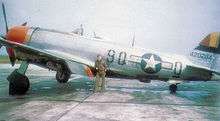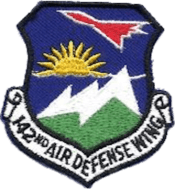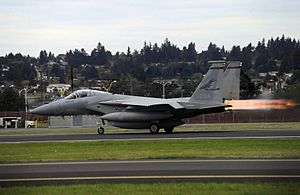142nd Fighter Wing
| 142nd Fighter Wing | |
|---|---|
|
An Oregon Air National Guard F-15C Eagle takes off from the Portland Air National Guard Base Oct. 2, 2010. | |
| Active | 1943–Present |
| Country |
|
| Allegiance |
|
| Branch |
|
| Type | Wing |
| Role | Fighter/Air Defense |
| Part of | Oregon Air National Guard |
| Garrison/HQ | Portland Air National Guard Base, Portland, Oregon |
| Nickname(s) | Redhawks |
| Tail code | Red tail stripe "Redhawks" "Portland OR" with flying hawk graphic "Oregon" |
| Website | http://www.142fw.ang.af.mil/ |
| Commanders | |
| Current commander | COLONEL DUKE A. PIRAK |
| Insignia | |
| 142nd Fighter Wing emblem |
 |
| Aircraft flown | |
| Fighter | F-15 |
The 142nd Fighter Wing (142 FW sometimes 142d) is a unit of the Oregon Air National Guard, stationed at Portland Air National Guard Base, Oregon.
As a state militia unit, the 142nd Fighter Wing is not in the normal United States Air Force chain of command. It is under the jurisdiction of the Oregon Air National Guard unless it is federalized by order of the president of the United States. If activated to federal service, the wing is gained by the United States Air Force Air Combat Command.
The 123rd Fighter Squadron assigned to the wing's 142nd Operations Group, is a descendant organization of 123rd Observation Squadron, formed on 30 July 1940. It is one of the 29 original National Guard Observation Squadrons of the United States Army National Guard formed before World War II.
Overview
The 142nd Fighter Wing participates around the globe supporting drug interdiction, USAFE air defense, as well as contingency operations such as Operations Noble Eagle, Enduring Freedom, and Iraqi Freedom. The wing serves the nation, state, and community by providing mission-ready units, personnel, and equipment for:
- Air defense of the Pacific Northwest
- Domination of the air superiority arena
- Federal augmentation in support of national security objectives
- Response to state and local contingencies
- Proactive involvement in activities that add value to the people and communities which it serves
Today the fighting "Redhawks" continue service as a component of the total force flying the F-15C/D, providing air defense and air superiority capabilities. With more than 1,000 officers and airmen, the unit guards the Pacific Northwest skies from northern California to the Canada–US border, on 24-hour alert as part of the North American Air Defense (NORAD) system.
Units

To complete these missions, four groups are assigned to the 142nd Fighter Wing
- 142nd Operations Group
- 116th Air Control Squadron, Camp Rilea AFTC, Warrenton
- 123rd Fighter Squadron
- 125th Special Tactics Squadron
- 123rd Weather Flight
- 142nd Maintenance Group
- 142nd Mission Support Group
- 142nd Medical Group
In addition, the Portland, Oregon Air National Guard Base is host to several tenant units as well as the Air Force Reserve 304th Rescue Squadron.
History
World War II

Formed at Westover Field, Massachusetts in August 1943 and trained in the mid-Atlantic area, they moved to the European theater during February and March 1944 and served in combat with Ninth AF from April 1944 to May 1945.
Began operations, using P-47s, by making a fighter sweep over France. Flew fighter- sweep, dive-bombing, and escort missions prior to the invasion of the continent. Attacked railroads, trains, vehicles, gun emplacements, and buildings in France during the invasion of 6 June 1944. Patrolled beachhead areas and continued its assaults against the enemy during the remainder of the Normandy campaign. Participated in the aerial barrage that prepared the way for the Allied breakthrough at St Lo on 25 July, and supported the subsequent drive across northern France.
Operated in the area of northeastern France and southwestern Germany during the fall and winter of 1944–1945, attacking such targets as storage dumps, trains, rail lines, marshalling yards, buildings, factories, bridges, roads, vehicles, and strong points. Conducted operations that supported Allied ground action in the Battle of the Bulge, December 1944– January 1945. Launched a series of attacks against vehicles, factories, buildings, railroad cars, tanks, and gun emplacements during the period 15–21 March 1945, being awarded a DUC for this six-day action that contributed to the defeat of the enemy in southern Germany.
Continued operations until May 1945. Returned to the US, October and November 1945 and inactivated.
Oregon Air National Guard
The wartime 371st Fighter Group was re-activated and re-designated as the 142nd Fighter Group, and was allotted to the Oregon Air National Guard, on 24 May 1946. It was organized at Portland Municipal Airport, Oregon, and was extended federal recognition on 30 August 1946 by the National Guard Bureau. The 142nd Fighter Group was bestowed the history, honors, and colors of the 371st Fighter Group. The group's 123rd Fighter Squadron was equipped with P-51D Mustangs and was assigned to the Fourth Air Force, Air Defense Command.
Korean War activation
The group was federalized and brought to active duty on 2 March 1951. It was assigned to the Air Defense Command Western Air Defense Force. It was then reassigned to the federalized Washington ANG 142nd Fighter-Interceptor Wing on 11 April and moved to O'Hare International Airport, Chicago, Illinois, by 1 May 1951. Re-designated 142nd Fighter-Interceptor Group on 1 May 1951. At O'Hare, the 142nd Fighter Group controlled the 62nd Fighter-Interceptor Squadron, flying F-86A Sabre day interceptors.
The group was inactivated on 6 February 1952, being replaced by the 4706th Air Defense Wing.
Cold War

Re-formed as the 142nd Fighter-Interceptor Group, flying F-86F Sabre day interceptor aircraft. It resumed its peacetime mission of the air defense of Oregon. Was upgraded by ADC in 1955 to the dedicated F-94A Starfire all-weather interceptor. With this new aircraft, the mission of the 123rd Fighter-Interceptor Squadron changed from day interceptor to day and night all-weather interceptor. In 1957 the 123rd again upgraded to the improved F-89J Scorpion then in 1966 to the supersonic F-102A Delta Dagger. In the summer of 1958, the 142nd implemented the ADC Runway Alert Program, in which interceptors of the 123rd Fighter-Interceptor Squadron were committed to a five-minute runway alert 24/7/365. The runway alert continues to this day.
In 1972 it received the Mach-2 F-101B Voodoo. As an example of the unit's readiness and capability, in 1976, the unit won top honors at a pair of Aerospace Defense Command (ADC) competitions, the Weapons Loading Competition and the famous William Tell Air Defense Competition. In William Tell 1976, the 142nd garnered first place in the F-101 category and Lieutenant Colonel Don Tonole and Major Brad Newell captured the overall "Top Gun" title flying the McDonnell F-101B Voodoo.
After the inactivation of Aerospace Defense Command in 1979 and the reassignment to Tactical Air Command (ADTAC), the 123rd began receiving F-4C Phantom II aircraft used in the interceptor mission beginning in 1981. Success came again at William Tell 1984 when the unit placed first in the F-4 category flying the McDonnell-Douglas F-4C Phantom II and beat many of its F-15 Eagle and F-106 Delta Dart rivals in the overall competition. Majors Ron Moore and Bill Dejager were the overall F-4 "Top Guns" of the competition.
In 1985, as part of the retirement of the F-4C from the inventory, the Oregon Air National Guard began to receive F-15A Eagles from active-duty units receiving the upgraded F-15C. Since the end of the Cold War, the 142nd has served as the principal air defense unit of the Pacific Northwest. In 1992, as part of a large USAF reorganization, both the group and squadron were re-designated yet again as the 142nd Fighter Group and the 123rd Fighter Squadron, respectively. In 1995 the group was elevated to wing status, beginning its current designation as the 142nd Fighter Wing.
The wing participated in a wide variety of expeditionary and humanitarian assistance missions in the turbulent post-Cold War environment while providing air defense of the Pacific Northwest. These included major deployments to Turkey in 1998 for Operation Northern Watch and to Saudi Arabia in 2000 for Operation Southern Watch, patrolling the no-fly zones then in place over Iraq. The wing deployed aircraft to Panama in 1998 in support of counter-drug missions, helping stem the flow of the drug trade by air. Wing personnel deployed on various other missions, sending medical troops to Belize, civil engineers to Macedonia, and to such places around the globe as Curaçao, Denmark, Germany, Guam, Kuwait, Spain and the United Kingdom.
Global War on Terrorism
On 11 September 2001, the wing was one of the first units to respond to the terrorist attacks on the east coast with increased air defense to enhance security on the west coast, and subsequently participated in Operation Noble Eagle, the national military response to homeland defense.
In the 50th Year of William Tell Anniversary Competition held in 2004, the 142nd Fighter Wing was rated first in maintenance, element attack and gun categories. These William Tell successes demonstrate Oregon's long history of excellent performance and readiness to accomplish the real world mission.
In 2004, unit personnel provided humanitarian aid in the wake of Hurricanes Katrina and Rita and the 2007 floods in Vernonia, Oregon. The wing also supported ongoing contingency operations in Southwest Asia, including Operation Iraqi Freedom and Operation Enduring Freedom, such as in the 2004 deployment of medical personnel to Qatar and the 2009 deployment of Security Forces Squadron personnel to Iraq.
In 2005, the early 1970s F-15A model were retired and the squadron received its current aircraft, the F-15C Eagle. With more than 1,000 officers and airmen, the 142nd Fighter Wing guards the Pacific Northwest skies from northern California to the Canada–US border, on 24-hour Air Sovereignty Alert as part of Air Combat Command the North American Aerospace Defense Command (NORAD). The wing also stands ready to participate in state and federal contingency missions as required.
The base was selected by the 2005 BRAC to close. Eleventh-hour negotiations between the political delegations from the states of Washington and Oregon saved the base from closure. Ironically the argument made by several groups to save the base was that of the NORAD mission it performed and the air cover it provided for the Pacific Northwest was essential to homeland security. However, the 2005 BRAC commission recommended keeping a small detachment in place at the base in order to support NORAD but close all other operations. As part of the recommendations of the 2005 BRAC, the Air Force Reserve Command's 939th Air Refueling Wing, which flew KC-135 aircraft and was collocated on the Portland Air National Guard Station, terminated operations.
On 26 June 2007, an F-15 Eagle from the 142nd Fighter Wing crashed into the Pacific Ocean during a simulated dogfight. Two F-15s from the 142nd were flying with two F/A-18 Hornets from Naval Air Station Fort Worth Joint Reserve Base performing dissimilar air combat training. The United States Coast Guard performed a search using two HH-60 Jayhawks, two Coast Guard Cutters, and one HC-130 Hercules. The night of the crash, the pilot, Major Gregory Young's body was found 40 miles west of Cannon Beach, Oregon.[1] The crash was due to unrecognized spatial disorientation, which caused the pilot to misperceive his attitude, altitude, and airspeed until his aircraft impacted the water.
In August 2010, two F-15 Eagles from this wing were dispatched in response to an airspace violation while the president visited Seattle, Washington. The jets produced two sonic booms over the Seattle skyline, the civilian Cessna 182 left restricted airspace before the jets arrived.
Lineage

- Constituted as 371st Fighter Group on 25 May 1943
- Activated on 15 July 1943
- Inactivated on 10 November 1945
- Re-designated: 142nd Fighter Group. Allotted to Oregon ANG on 24 May 1946.
- Extended federal recognition on 30 Aug 1946
- Established as 142nd Fighter Wing, extended federal recognition and activated on 1 November 1950
- 142nd Fighter Group assigned as subordinate unit
- Federalized and placed on active duty, 2 March 1951
- Re-designated: 142nd Fighter-Interceptor Wing on 2 March 1951
- Inactivated on 6 February 1952
- Returned to Oregon state control and activated on 1 November 1952
- Re-designated: 142nd Air Defense Wing, 16 April 1956
- Group re-designated as 142nd Fighter Group (Air Defense)
- Re-designated: 142nd Fighter-Interceptor Wing, 1 July 1960
- Group re-designated as 142nd Fighter-Interceptor Group
- Re-designated: 142nd Fighter Wing 16 March 1992
- Group re-designated as 142nd Operations Group
Assignments
- I Fighter Command, 15 July 1943
- Attached to: Philadelphia Fighter Wing, 30 September 1943 – 14 February 1944
- IX Fighter Command, April 1944
- 100th Fighter Wing, 1 August 1944
- Attached to: XIX Tactical Air Command, 1 August 1944
- XIX Tactical Air Command, 29 September 1944
- 1st Tactical Air Force (Provisional), 1 November 1944
- XIX Tactical Air Command, 16 February 1945 – October 1945
- Army Service Forces (for inactivation), 9–10 November 1945
- 60th Fighter Wing, 30 August 1946
- Oregon Air National Guard, 31 October 1950
- Gained by: Fourth Air Force, Air Defense Command
- 142nd Fighter-Interceptor Wing (WA ANG), 2 March 1951 – 6 February 1952
- Oregon Air National Guard, 1 November 1952 – Present
- Gained by: Western Air Defense Force, Air Defense Command
- Gained by: Portland Air Defense Sector, Air Defense Command, 8 June 1958
- Gained by: 26th Air Division, Air Defense Command, 1 April 1966
- Gained by: 26th Air Division, Aerospace Defense Command, 15 January 1968
- Gained by: Air Defense, Tactical Air Command (ADTAC), 1 October 1979
- Gained by: First Air Force, Tactical Air Command, 9 December 1985
- Gained by: Northwest Air Defense Sector (NWADS), 1 July 1987
- Gained by: Western Air Defense Sector (WADS), 1 October 1997–Present
Components
World War II
- 404th Fighter Squadron (9Q): 15 July 1943 – 10 November 1945
- 405th Fighter Squadron (8N): 15 July 1943 – 10 November 1945
- 406th Fighter Squadron (4W): 15 July 1943 – 10 November 1945
Air National Guard
- 141st Fighter Group (Air Defense), 16 April 1956 – 1 July 1960
- 142nd Operations Group, 11 October 1995 – Present
- 142nd Tactical Fighter Training Group, 1 January 1983 – 15 March 1992
- 114th Fighter Squadron, 15 March 1992 – 1 April 1996 (GSU at Kingsley Field, OR)
- 116th Fighter (later Fighter-Interceptor) Squadron, 31 October 1950 – 10 February 1951; 1 November 1952 – 16 April 1956
- 123rd Fighter (Later Fighter-Interceptor, Fighter) Squadron, 30 August 1946 – Present
Stations
|
|
Aircraft
|
|
Decorations
References
![]() This article incorporates public domain material from the Air Force Historical Research Agency website http://www.afhra.af.mil/.
This article incorporates public domain material from the Air Force Historical Research Agency website http://www.afhra.af.mil/.
- ↑ "Archived copy" (PDF). Archived from the original (PDF) on 4 March 2016. Retrieved 2014-10-16.
- ↑ "Air Force Personnel Center Awards Search post-1991". Air Force Personnel Center. Archived from the original on 24 January 2008.
- Maurer, Maurer (1983). Air Force Combat Units Of World War II. Maxwell AFB, Alabama: Office of Air Force History. ISBN 0-89201-092-4.
- Johnson, David C. (1988), U.S. Army Air Forces Continental Airfields (ETO), D-Day to V-E Day; Research Division, USAF Historical Research Center, Maxwell AFB, Alabama.
External links
| Wikimedia Commons has media related to Oregon Air National Guard. |
- 142nd FW home page
- "Air Force Magazine article on the 142nd" (PDF). The Air Force Association. Archived from the original (PDF) on 11 February 2012.




.svg.png)
.jpg)